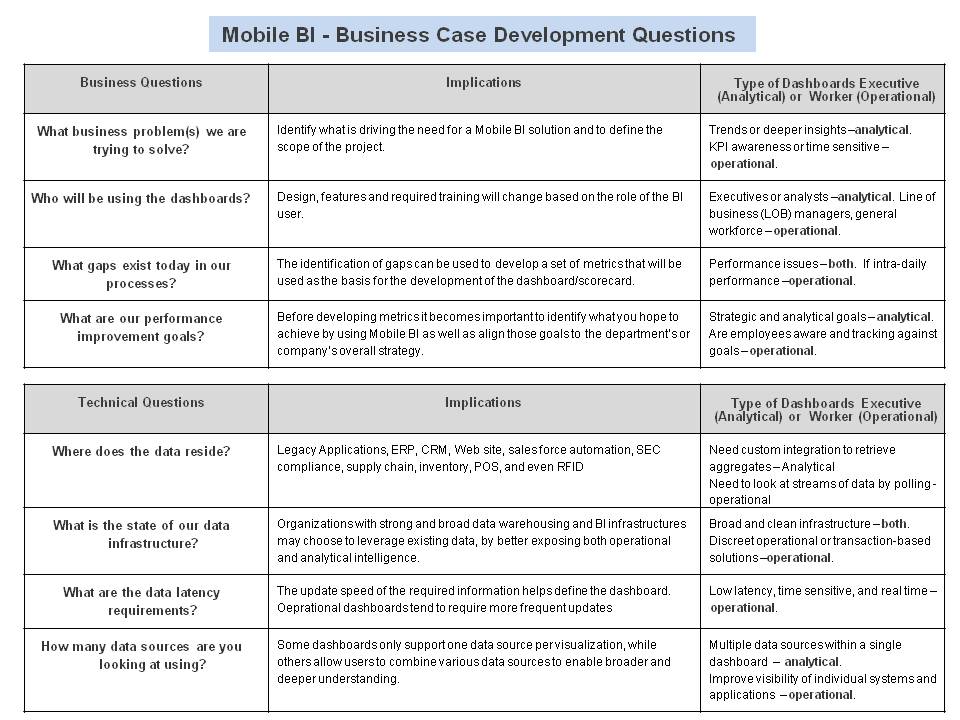Business intelligence (BI), and information management, is a natural fit for mobile devices. Managers, blue and white workers, today spend a majority of their time away from their desks. Most are traveling, walking about or driving from site to site. And it’s these mobile workers who often need the most up-to-date information. They need business intelligence to retrieve data to make on-the-spot decisions, monitor operational processes and review dashboards on different processes.
Mobile BI addresses a big complaint against analytics and information management for many years – not easy to consume, chart and data overload, devices not secure. Not anymore. Tablet devices are just right for mobile BI – small enough to carry and large enough to be effective. The early success of the iPad for BI has caught many experts by surprise.
Numerous corporations are leveraging the iPhone, iPad and Android phones to improve productivity via business-driven, data-rich mobile BI apps that transform how mobile executives and field users consume data and make informed business decisions.
As mobile becomes a must-have channel, not a nice-to-have afterthought, the apps are getting more sophisticated (richer graphics and more easily consumable information on demand); and this further fuels adoption. We are moving away from the “shrink to fit” method of taking legacy business applications and simply downsizing them for the smaller, mobile screen. Shrink-to-fit is a dominant practice among major providers of BI that was not well received by users.
Types of mobile BI dashboards and scorecards
What is your mobile BI strategy? The business case for mobile BI is no longer hard to build.
Typically there are two types of dashboard/scorecard apps: executive level and employee level.
- The executive dashboard enables management to track key performance indicators (KPIs) across their enterprise and monitor the pulse of the business.
- The operational dashboard enables operational workers to monitor day-to-day operational activity and task performance.
Both types of dashboards display performance status according to plan and enable users to drill into detailed data and view time series charts that reflect past and future trends.
The data for executive dashboards usually comes from a data mart or data warehouse and consists of both summary and detail data loaded on a daily or weekly basis. However, if the dashboard tracks operational activity, then the data either comes from a real-time-enabled data warehouse or directly from operational systems via real-time queries.
What makes Mobile BI interesting in industries like Travel, Retail and others with heavy consumer focus is the ability to integrate camera and maps into the BI mashups. So-Lo-Mo (social, local, mobile) is creating new analytics opportunities.
Mobile BI development approaches to dashboards and scorecards
Typically the vendors and companies use different mobile app development approaches:
- Native app development – Purpose-built, workflow-driven apps that quickly and easily guide users through their data to discovery, analysis or decision. Apps fully leverage mobile device capabilities including the multi-touch interface, sensors (GPS or camera), communications (voice, email, text) and more.
- HTML5 for mobile
- Hybrid approach using the PhoneGap platform
- Intermediary solutions like RoamBI, Geckoboard and the Klipfolio dashboard, that leverage open Web standards to deliver BI visualizations that are comparable to native apps
For all type of dashboards, mobile device security remains a concern. So companies need to evaluate risk of information loss and train users accordingly. Sensitive data needs to be secured with additional layers of protection as necessary.
Vendors like MicroStrategy have recently made several mobile security upgrades to better support iPad and iPhone deployments. For instance, encryption is now applied to data while in transit from the MicroStrategy Mobile server to the MicroStrategy Mobile client (and when it is stored on the device). An authentication mode lets administrators set apps to require secure logons. User credentials are validated against the Mobile Server while online and against locally cached and encrypted credentials while offline. Administrators can remotely revoke access requests from specific devices.
All the large vendors – SAS, IBM (Cognos + SPSS), SAP and others – have sophisticated data analytics to feed visualizations. What they lack is the front-end sizzle, ease-of-use and simplicity. This is where the new entrants are taking market share and establishing a foothold.
Going forward
Mobile intelligence has evolved from basic BI reports and dashboards on a mobile device to proactive apps that change the way people work.
Mobile BI is poised to revolutionize the way organizations deliver, consume and act on information. The convergence of information and analytics with mobile technology is empowering highly personalized channels of intelligence.
However, the ultimate test of the mobile BI revolution is better decisions and improved productivity.
Do you have a Mobile BI strategy?
Shirish Netke is EVP Business Analytics Solutions at Saama Technologies, where he focuses on building business-specific analytics solutions. Ravi Kalakota is Managing Director at Alvarez & Marsal, a restructuring, turnaround, performance improvement, and business consulting firm.
This excerpt is republished with permission from Business Analytics 3.0. The entire article is available here.

